by Dave Senf
December 2020
The Minnesota Index advanced for the sixth month in a row in November, but the pace of improvement slowed noticeably. November’s 1.1% increase was off from the 3.3% monthly average gain over the previous five months. Minnesota’s index increased faster than the U.S. index for the sixth straight month as the U.S. Index increased by only 0.3% in November. Since both indices are proxies for monthly economic activity, the robust expansion by Minnesota’s index relative to the U.S. index implies that Minnesota’s economy has been expanding faster than the U.S. economy during the last six months. Three components of the index fueled November’s advancement, but declining wage and salary employment kept the index from increasing more. Minnesota’s unemployment rate fell for a sixth consecutive month, inching down to 4.4% from 4.6% in October. The state’s unemployment rate peaked in May a 9.9%. The improving unemployment rate has in part been from individuals dropping out of the labor force. The state’s labor force has declined by 77,000 individuals or 2.5% since June. November’s unemployment decline was positive since labor force and employed numbers were up, and unemployed numbers were down. Average weekly manufacturing hours and wage and salary compensation were the two other component of the index that improved in November.
Minnesota’s index is down 1.3% from a year ago while the U.S. index is down 4.3% over the year. The Minnesota Index is still 2.8% lower than its peak in March while the U.S. index is 4.9% behind its peak reached in February. Based on state coincident indices (which is what the Minnesota Index is) 10 states, led by Utah, Kentucky and Delaware, had higher GDP in November than in March before the pandemic took hold. Minnesota has the 26th largest GDP gap for the same period, with the state’s level of economic activity down 2.8%. Hawaii and Maryland had the largest March to November gaps at 21.6% and 10.8%. Iowa’s economy was 1.6% below its March level, while South Dakota was 4.0% lower, Wisconsin 4.3% lower, and North Dakota 9.7% lower.
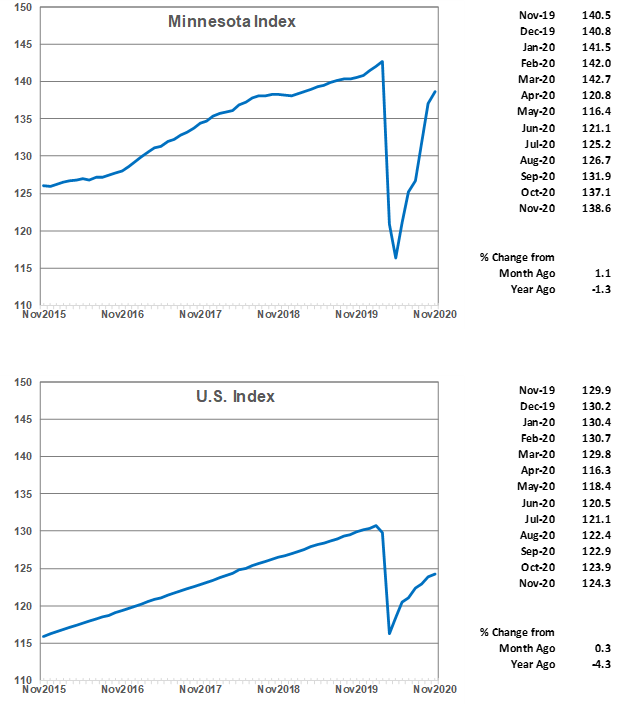
After climbing for six months, Minnesota’s adjusted Wage and Salary Employment tailed off in November by 0.5%. Job loss totaled 12,600 which nearly wiped out October’s 15,200 increase. Job growth nationally was 0.2% in November, the slowest monthly job growth since the job rebound began in May. Minnesota job growth was stronger than nationwide during the previous four months but fell behind in November. The state has recovered roughly 49.8% of the 387,800 jobs lost in March and April over the last seven months while nationally 55.6% of the 22.2 million jobs lost across the nation in March and April have been recovered.
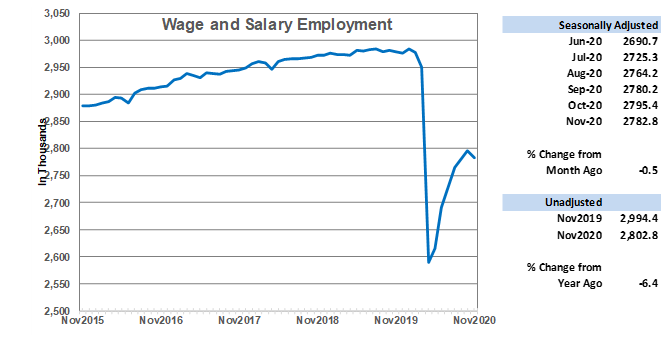
The private sector accounted for the majority of job loss in November as private payroll numbers dipped by 10,300 while public payroll numbers slipped 2,300. Six supersectors cut payrolls, four added workers, while the other saw no change in payroll numbers. Leisure and Hospitality lost the most jobs followed by Government, Manufacturing, and Construction. Financial Activities added 2,100 jobs in November, its highest monthly jump since early 2005. Hiring was also strong in Professional and Business Services and Educational and Health Services. The Goods-producing sector lost 3,400 jobs in November, ending a three-month streak of job growth. Service-providing sector employment dropped by 9,200, ending six months of job expansion.
Minnesota’s unadjusted employment in November was down 6.4% or 192,000 jobs from a year ago. Unadjusted employment nationwide was down 6.0% over the year or roughly 9.2 million jobs. Idaho was the only state with more wage and salary employment in November 2020 than November 2019. Hawaii and New York had the highest year-over-year declines, 15.2% and 9.9%. Minnesota’s 6.4% annual drop off was the 18th largest. South Dakota’s over the year decline was 2.9%, Iowa (5.1%), Wisconsin (6.9%), and North Dakota (7.0%).
Online Help-Wanted Ads climbed for the fourth straight month to 117,500. The 11.3% jump was slightly higher than the nationwide 10.3% increase. Online help-wanted ads in Minnesota are down 15% from March compared to 13.4% for the U.S. Labor demand continues to run below levels prior to the pandemic in Minnesota and across most regions of the nation. Minnesota’s online job postings continue to account for roughly 2.2% of all U.S. job postings which is slightly higher than the 1.8% share of total nationwide payroll jobs accounted for by Minnesota in October.
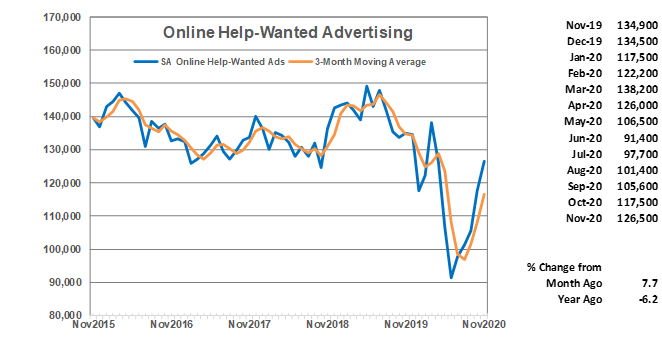
Minnesota’s Purchasing Managers’ Index (PMI) retreated from its record-high last month to 73.5 in November. The PMI is a composite index of survey responses from purchasing managers of manufacturing companies. Purchasing managers are asked if they expect production, inventories, employment, new orders, and delivery lead time to increase or decrease next month. They are not asked about the rates of increase or decrease, just if increases or decreases are expected. The index ranges from 0 to 100% with a reading above 50 indicating expansion over the next few months.
November’s 73.5 reading is the fourth highest in the index’s 26-year history and suggests that Minnesota manufacturers remain very optimistic about business picking up over the next few months. Two similar indices, the national ISM Manufacturing Index and the Mid-America Business Index, also dipped in November, tailing off to 57.5 and 69.0 respectively.
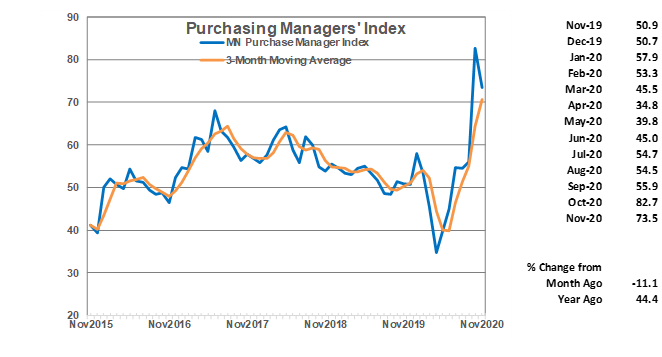
Average weekly Manufacturing Hours increased for the second straight month to 41.1, the highest since last November. The longer factory workweek is consistent with Minnesota’s robust PMI index. The 1,900 manufacturer jobs cut in November seems inconsistent with manufacturing activity heating up, so look for a positive revision next month.
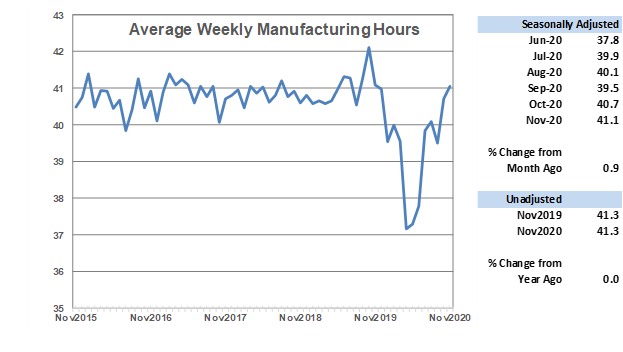
Average weekly Manufacturing Earnings dropped in November to $967.47 but remain near record highs in real terms. November’s average weekly paycheck ranks as the fourth highest dating back to 1970. November’s high average weekly factory paycheck, along with increasing weekly factory hours, implies that manufacturing activity in the state continues to rebound from its pandemic drop.
Minnesota manufacturing production employees’ average hourly earnings in November were $23.69 and rank 12th highest among the states. Connecticut ($29.52) and Washington ($27.73) had the highest hourly earnings while North Carolina ($19.12) and Arkansas ($18.97) had the lowest. Average hourly earnings in neighboring states were Wisconsin ($22.21), North Dakota ($21.96), Iowa ($21.33), and South Dakota ($19.79).
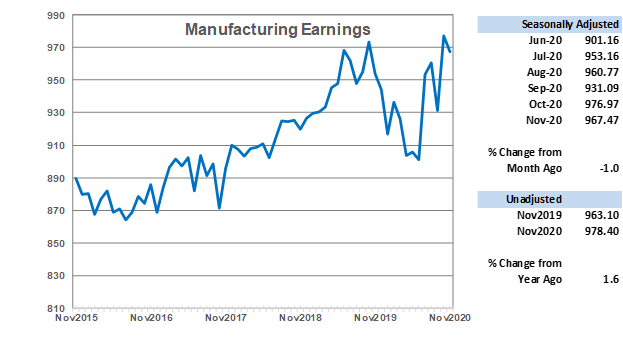
Adjusted Residential Building Permits rose to 2,551 in November, keeping Minnesota’s homebuilding industry’s solid year on track. Residential building permits in the state accounted for 2.0% of nationwide permits in November and 2.1% for the first 11 months of the year. The 2.0% share of homebuilding permits is slightly higher than Minnesota’s 1.7% of the U.S. population.
Homebuilding activity continues to be a leader during the bumpy economic recovery. Low inventory of existing homes for sale plus near-record low mortgage rates has sparked interest in home buyers looking to build.
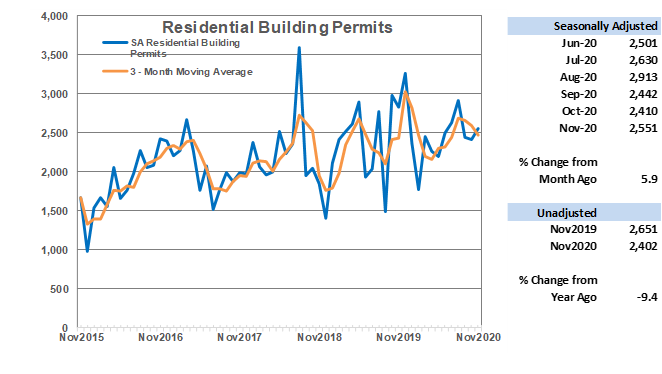
Adjusted Initial Claims for Unemployment Benefits (UB) declined for the seventh month in a row after spiking in March and April. The 18.4% decline in November was the largest monthly decline since June but was caused more by seasonal adjustment factors than actual declining initial claims. Unadjusted initial claims increased from 48,754 in October to 84,009 in November. This was below the usual difference in October and November initial claims level; thus, November’s seasonally adjusted level was reported as dropping compared to October.
Workers continue to be laid off at rates significantly above pre-pandemic levels as initial claims in November, adjusted or unadjusted, remain elevated. November’s unadjusted level is over three times higher than a year ago. November’s seasonally adjusted level of 49,724 was also three times higher than February’s 16,361. Expect initial claims numbers to move backwards in December as businesses respond to new restrictions.
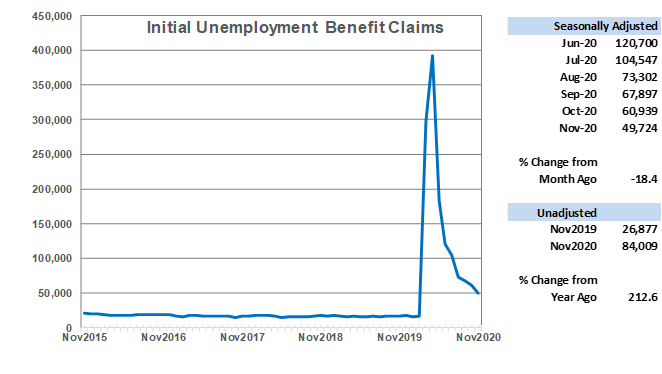
Note: All data except for Minnesota’s PMI have been seasonally adjusted. See the feature article in the Minnesota Employment Review, June 2010, for more information on the Minnesota Index.
The Philadelphia Federal Reserve Bank, which produces the Minnesota Leading Index, has temporary suspended generation of state leading indices.